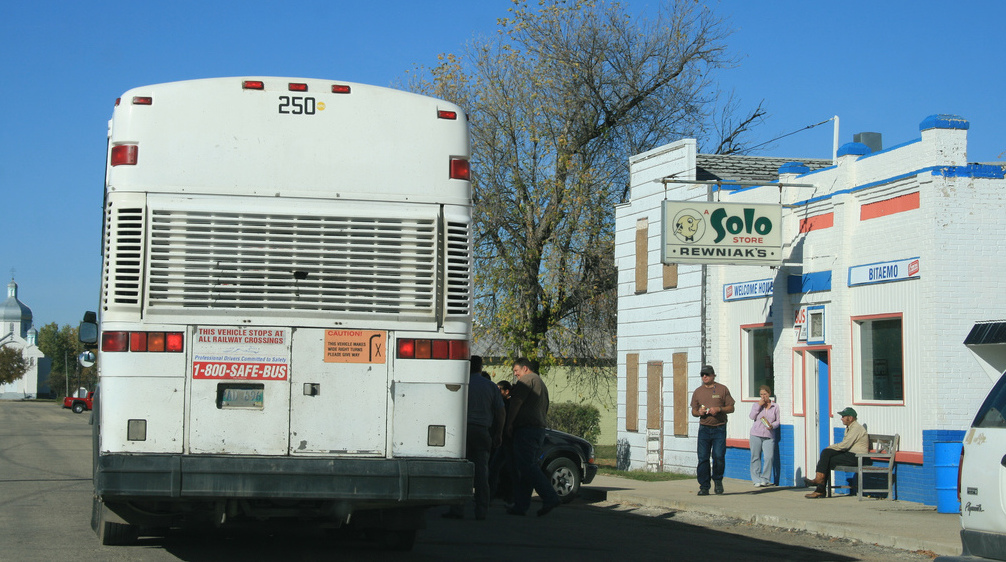Growing up in small-town Saskatchewan, I remember being in awe every time I happened on Main Street when the Greyhound bus was in town. So huge (compared to my kid stature); so exciting, with people coming and going. The bus always parked in front of the Town and Country Cafe — so those waiting for the bus or those on a stopover could have a coffee or something to eat.
The bus arrived and left often — twice a day if my recollection is right. There was the 8 a.m. bus and the 8 p.m. — morning and night you could hop on a bus and stop pretty much anywhere along the line of small towns and small urban centres.
That could have been the scene in any Prairie town of the day — and stopovers could have been near the Paris Cafe, or Wong’s Cafe, or coffee row anywhere. Farmers and residents alike planned their trips on the bus, and also used it to receive and ship parts for crucial farm equipment or packages for birthdays and holidays.
Later, the bus only stopped once a day, and briefly, at an outlying gas station. And then later yet, it only came in twice a week, and anyone heading to the city for medical appointments or business had to plan to stay overnight somewhere. Urgent repairs were still shipped but delays impacted seeding and harvest.
And now… well, the bus just doesn’t run anymore.
The announcement of the closure of Greyhound’s western routes left me dazed. It also brought to light that Greyhound has cancelled bus services in northern British Columbia recently. In Saskatchewan, the provincial government cancelled the Saskatchewan Transportation Company — the STC bus service — in 2017. So without STC and Greyhound, there is no bus service in Saskatchewan!
Western Canada has been largely abandoned by Greyhound, with only one remaining route between Vancouver and Seattle.
How is my aunt in small-town Saskatchewan supposed to get to see her specialist? By ambulance? How are students supposed to get home from university? How is anybody who does not own a car supposed to get around? How are people supposed to contemplate living in small towns when it is so easy to be cut off and isolated?
With this recent announcement, it’s urgent for the federal government to fund a national transportation system that links communities in this country, no matter whether those communities are rural or urban. It also needs to consider environmental issues and the renewal of train service.
In previous columns I noted that the network of rail lines should become part of a national, affordable, train network — enabling people to live in or visit rural areas. This type of investment would send a strong signal to rural people that the federal government understands that not everyone can or wants to live in the middle of Toronto, Vancouver, or even Regina.
Better yet, it would signal that not everyone should — and that rural economies and the people who work hard to stoke them — farmers, small businesspeople, dentists, doctors, nurses, community groups — make a valuable contribution to their communities and to Canada, and have the right to affordable and accessible transportation services.
Of course, Greyhound’s decision is not a huge surprise. Private transportation companies (and even public ones sometimes as in the case of STC) are all about the bottom line and Greyhound’s parent company is in the United States. It is wishful thinking that an American company would even try to understand the Canadian context.
It is easy to say that there is not enough of a population or ridership to support a bus system. But dig a bit deeper and consider: why is that?
I have also written in this column about the loss of family farmers and the rural depopulation of the last decades. With no solid public transportation in Western Canada, unless something is done on the part of the federal government to maintain a transportation system, it will be clearer than ever that rural abandonment is a national policy in this country.
While it is true that transportation companies have a bottom line, it is also about how you calculate that bottom line. Are larger and larger cities actually sustainable? Are larger and larger farms environmentally smart? How do you measure quality of life?
Without strong agricultural policies to encourage rural repopulation, what we have seen take place over the last half century will continue. There are fewer and fewer family farmers, fewer businesses in rural towns, and fewer services overall because the town and municipal tax base simply cannot afford it. And so the cycle goes.
What about rural rejuvenation, or the possibilities of encouraging renewal of family farms? What about food security and food sovereignty? What about realizing that rural economies and agriculture are necessary if urban areas are to thrive?
There can be no commitment to a national agricultural policy built on sustainable family farms if the federal government cannot provide a national transportation network.
Lois Ross is a communications specialist, writer, and editor, living in Ottawa. Her column “At the farm gate” discusses issues that are key to food production here in Canada as well as internationally.
Photo: seniwati/Flickr




